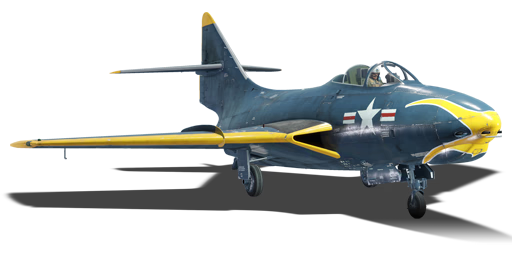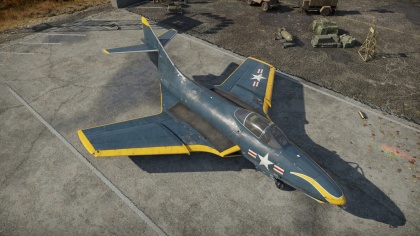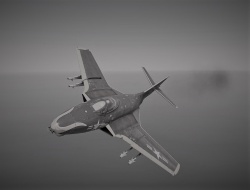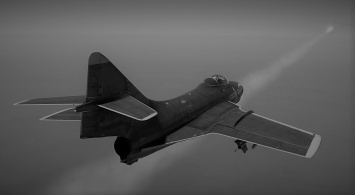Difference between revisions of "F9F-8"
(→Flight Performance: Updated flight performance stats and added engine table) |
|||
| Line 20: | Line 20: | ||
{| class="wikitable" style="text-align:center" | {| class="wikitable" style="text-align:center" | ||
| − | + | ! rowspan="2" | Characteristics | |
| − | ! | ||
| − | |||
| − | |||
| − | |||
! colspan="2" | Max Speed<br>(km/h at 610 m) | ! colspan="2" | Max Speed<br>(km/h at 610 m) | ||
| − | ! rowspan="2" | Max altitude<br>( | + | ! rowspan="2" | Max altitude<br>(metres) |
! colspan="2" | Turn time<br>(seconds) | ! colspan="2" | Turn time<br>(seconds) | ||
| − | ! colspan="2" | Rate of climb<br>( | + | ! colspan="2" | Rate of climb<br>(metres/second) |
| − | ! rowspan="2" | Take-off run<br>( | + | ! rowspan="2" | Take-off run<br>(metres) |
|- | |- | ||
| − | ! AB | + | ! AB !! RB !! AB !! RB !! AB !! RB |
| − | ! RB | ||
| − | ! AB | ||
| − | ! RB | ||
| − | ! AB | ||
| − | ! RB | ||
|- | |- | ||
| − | |1,019||988|| {{Specs|ceiling}} ||33.7||34.3|| | + | ! Stock |
| + | | 1,019 || 988 || rowspan="2" | {{Specs|ceiling}} || 33.7 || 34.3 || 22.1 || 20.6 || rowspan="2" | 500 | ||
|- | |- | ||
| − | ! | + | ! Upgraded |
| − | | | + | | ??? || ??? || ??.? || ??.? || ??.? || ??.? |
| − | |||
| − | |||
| − | |||
| − | |||
| − | |||
| − | |||
| − | |||
| − | |||
| − | |||
| − | |||
| − | |||
| − | |||
| − | |||
| − | | ? | ||
|- | |- | ||
|} | |} | ||
| Line 62: | Line 40: | ||
{| class="wikitable" style="text-align:center" | {| class="wikitable" style="text-align:center" | ||
|- | |- | ||
| − | ! colspan=" | + | ! colspan="6" | Features |
|- | |- | ||
| − | ! Combat | + | ! Combat flaps !! Take-off flaps !! Landing flaps !! Air brakes !! Arrestor gear !! Drogue chute |
| − | ! Take-off | ||
| − | ! Landing | ||
| − | ! Air brakes | ||
| − | ! Arrestor gear | ||
|- | |- | ||
| − | | X || X || ✓ || ✓ || ✓ <!-- ✓ --> | + | | X || X || ✓ || ✓ || ✓ || X <!-- ✓ --> |
|- | |- | ||
|} | |} | ||
| Line 76: | Line 50: | ||
{| class="wikitable" style="text-align:center" | {| class="wikitable" style="text-align:center" | ||
|- | |- | ||
| − | ! colspan=" | + | ! colspan="7" | Limits |
|- | |- | ||
| − | ! rowspan="2" | | + | ! rowspan="2" | Wings (km/h) |
| − | ! rowspan="2" | Gear | + | ! rowspan="2" | Gear (km/h) |
| − | ! | + | ! colspan="3" | Flaps (km/h) |
! colspan="2" | Max Static G | ! colspan="2" | Max Static G | ||
|- | |- | ||
| − | ! + | + | ! Combat !! Take-off !! Landing !! + !! - |
| − | ! - | ||
|- | |- | ||
| − | | {{Specs|разрушение|конструкции}} || {{Specs|разрушение|шасси}} || | + | | {{Specs|разрушение|конструкции}} || {{Specs|разрушение|шасси}} || N/A || N/A || 410 || ~9 || ~5 |
|- | |- | ||
|} | |} | ||
| Line 92: | Line 65: | ||
{| class="wikitable" style="text-align:center" | {| class="wikitable" style="text-align:center" | ||
|- | |- | ||
| − | ! colspan="4" | Optimal velocities | + | ! colspan="4" | Optimal velocities (km/h) |
|- | |- | ||
| − | ! Ailerons | + | ! Ailerons !! Rudder !! Elevators !! Radiator |
| − | ! Rudder | ||
| − | ! Elevators | ||
| − | ! Radiator | ||
|- | |- | ||
| − | | < 950 || < 790 || < 510 || | + | | < 950 || < 790 || < 510 || N/A |
|- | |- | ||
|} | |} | ||
| + | |||
| + | ==== Engine performance ==== | ||
{| class="wikitable" style="text-align:center" | {| class="wikitable" style="text-align:center" | ||
|- | |- | ||
| − | ! colspan="3" | | + | ! colspan="3" | Engine |
| + | ! colspan="6" | Aircraft mass | ||
| + | |- | ||
| + | ! colspan="2" | Engine name || Number | ||
| + | ! colspan="3" | Empty mass || colspan="3" | Wing loading (full fuel) | ||
|- | |- | ||
| − | + | | colspan="2" | Pratt & Whitney J48-P-8A || 1 | |
| + | | colspan="3" | 5,900 kg || colspan="3" | 286 kg/m<sup>2</sup> | ||
|- | |- | ||
| − | ! | + | ! colspan="3" | Engine characteristics |
| − | + | ! colspan="5" | Mass with fuel (no weapons load) || rowspan="2" | Max Takeoff<br/>Weight | |
| − | ! | ||
|- | |- | ||
| − | | | + | ! Weight (each) || colspan="2" | Type |
| + | ! 17m fuel || 20m fuel || 30m fuel || 45m fuel || 58m fuel | ||
|- | |- | ||
| − | + | | 600 kg || colspan="2" | Axial-flow turbojet | |
| − | + | | 6,796 kg || 6,952 kg || 7,472 kg || 8,253 kg || 8,929 kg || 9,636 kg | |
|- | |- | ||
| − | ! | + | ! colspan="3" | {{Annotation|Maximum engine thrust @ 0 m (RB / SB)|The maximum thrust produced by each engine, while mounted in the aircraft. NOTE: Thrust varies significantly depending on speed & altitude.}} |
| − | ! 100% | + | ! colspan="6" | Thrust to weight ratio @ 0 m (100%) |
| − | |||
|- | |- | ||
| − | | | + | ! Condition || 100% || WEP |
| + | ! 17m fuel || 20m fuel || 30m fuel || 45m fuel || 58m fuel || MTOW | ||
|- | |- | ||
| − | + | | ''Stationary'' || 3,182 kgf || N/A | |
| + | | 0.47 || 0.46 || 0.43 || 0.39 || 0.36 || 0.33 | ||
|- | |- | ||
| − | + | | ''Optimal'' || 3,182 kgf<br/>(0 km/h) || N/A | |
| − | + | | 0.47 || 0.46 || 0.43 || 0.39 || 0.36 || 0.33 | |
| − | |||
|- | |- | ||
| − | |||
| − | |||
|} | |} | ||
Revision as of 22:34, 23 January 2020
Contents
| This page is about the American naval jet fighter F9F-8. For other uses, see F9F (Family). |
Description
The F9F-8 Cougar is a rank American naval jet fighter
with a battle rating of (AB), (RB), and (SB). It was introduced in Update 1.63 "Desert Hunters".
General info
Flight Performance
Describe how the aircraft behaves in the air. Speed, manoeuvrability, acceleration and allowable loads - these are the most important characteristics of the vehicle.
| Characteristics | Max Speed (km/h at 610 m) |
Max altitude (metres) |
Turn time (seconds) |
Rate of climb (metres/second) |
Take-off run (metres) | |||
|---|---|---|---|---|---|---|---|---|
| AB | RB | AB | RB | AB | RB | |||
| Stock | 1,019 | 988 | 33.7 | 34.3 | 22.1 | 20.6 | 500 | |
| Upgraded | ??? | ??? | ??.? | ??.? | ??.? | ??.? | ||
Details
| Features | |||||
|---|---|---|---|---|---|
| Combat flaps | Take-off flaps | Landing flaps | Air brakes | Arrestor gear | Drogue chute |
| X | X | ✓ | ✓ | ✓ | X |
| Limits | ||||||
|---|---|---|---|---|---|---|
| Wings (km/h) | Gear (km/h) | Flaps (km/h) | Max Static G | |||
| Combat | Take-off | Landing | + | - | ||
| N/A | N/A | 410 | ~9 | ~5 | ||
| Optimal velocities (km/h) | |||
|---|---|---|---|
| Ailerons | Rudder | Elevators | Radiator |
| < 950 | < 790 | < 510 | N/A |
Engine performance
| Engine | Aircraft mass | |||||||
|---|---|---|---|---|---|---|---|---|
| Engine name | Number | Empty mass | Wing loading (full fuel) | |||||
| Pratt & Whitney J48-P-8A | 1 | 5,900 kg | 286 kg/m2 | |||||
| Engine characteristics | Mass with fuel (no weapons load) | Max Takeoff Weight | ||||||
| Weight (each) | Type | 17m fuel | 20m fuel | 30m fuel | 45m fuel | 58m fuel | ||
| 600 kg | Axial-flow turbojet | 6,796 kg | 6,952 kg | 7,472 kg | 8,253 kg | 8,929 kg | 9,636 kg | |
| Maximum engine thrust @ 0 m (RB / SB) | Thrust to weight ratio @ 0 m (100%) | |||||||
| Condition | 100% | WEP | 17m fuel | 20m fuel | 30m fuel | 45m fuel | 58m fuel | MTOW |
| Stationary | 3,182 kgf | N/A | 0.47 | 0.46 | 0.43 | 0.39 | 0.36 | 0.33 |
| Optimal | 3,182 kgf (0 km/h) |
N/A | 0.47 | 0.46 | 0.43 | 0.39 | 0.36 | 0.33 |
Survivability and armour
- 9.5 mm steel - in front of cockpit
- 8.5 mm steel - behind pilot
- 60 mm steel - armoured windscreen
Armaments
Offensive armament
The F9F-8 is armed with:
- 4 x AN/M3 20 mm cannon (190 RPG = 760 total)
Suspended armament
The F9F-8 can be outfitted with the following ordnance:
- Without load
- 4 х 500 lb AN-M64A1 bombs (2,000 lb total)
- 2 х 1000 lb AN-M65A1 Fin M129 bombs (2,000 lb total)
- 4 х AIM-9B Sidewinder air-to-air missiles
Usage in battles
First of your objective when you purchase this plane is to research as fast as you can the 20 mm cannons modifications. The F9F-8 default cannons get jammed in a quick burst.
This said don’t expect to defeat MiG-15 and MiG-17A very easily. The F9F-8 performs great defensing maneuvers and can keep up in turns with the MiGs (beware that doesn’t have the great acceleration that MiGs have).
This is not an air superiority aircraft, its main purpose is to support ground vehicles and planes.
The best tactics if you are new to this plane is to fly it like a F9F-2 or F9F-5 so stay near some allies and give them support.
- Never roll too hard over 750 km\h (466 mph) or the wings will explode
- Never execute maneuvers over –2 G or the wings will explode
Modules
| Tier | Flight performance | Survivability | Weaponry | ||
|---|---|---|---|---|---|
| I | Fuselage repair | Compressor | |||
| II | New boosters | Airframe | Offensive 20 mm | FLBC mk.1 | |
| III | Wings repair | Engine | New 20 mm cannons | ||
| IV | G-suit | Cover | AIM-9B | ||
Pros and cons
Pros:
- Good bombload options
- Four 20 mm cannons can shred enemy aircraft and light ground targets
- Slightly better top speed than on the F9F Panther
- Can equip with AIM-9 Sidewinder guided missiles
- Good roll rate over 800 kph (497 mph)
- Faster than its predecessors
Cons:
- Bad turn time overall; even the Hawker Hunter can turn tighter in some scenarios
- Top speed is not great but is not terrible either
- Can't equip rockets
- Cannot turn over -2G
- Rips very very easily in turns and rolls
- Not good at retaining energy, have to be very strict in order to keep it
- Poor acceleration
- Guns tend to jam quickly without New 20 mm upgrade
History
It was Grumman's engineers who first thought of developing their successful F9F Panther fighter into a swept-wing variant. The resulting Cougar was a very new design in many ways bucking post-war design trends. The fuselage, fin and rudder remained the same, however, the wings were completely new with a 35-degree sweep and lacking the distinctive wingtip tanks of the Panther. The engine was also an upgrade, a Pratt and Whitney J48 with an extra 1,000 kg of thrust over the previous J42. First flight was 20 September 1951, with operational trials starting three months later. Squadron deliveries began in November 1952. 706 F9F-6s with the original engine were produced, and 168 of the F9F-7 which used the Allison J33 turbojet instead.
The F9F-8 was the final version. Its prototype's first flight was December 1953. In this model, the fuselage was lengthened 30 cm to increase the space for fuel tanks. It had the J48-P-8 engines installed that gave it a total of 3,447kg of Thrust, the wings were also modified slightly to add an in-air refuelling probe plus the capability of mounting four Aim-9 sidewinders and a nose radar was fitted. In total, 601 F9F-8s were built.
The F9F-8 was too late to see combat in Korea, however, there were four trainer versions of the F9F-8 (F9F-8T) deployed to Vietnam and was used in airstrike directing for incoming allied aircraft.
The Argentine Navy was the only other nation to operate the F9F-8 and was the first jet aircraft that they ever had capable of breaking the sound barrier (In a dive).
It is also worth noting that the F9F-8 was redesignated, as part of the United States Tri-Service Designation System, to the F-9J in 1962.
Media
See also
External links
| Grumman Aircraft Engineering Corporation | |
|---|---|
| Aircraft | |
| Fighters | |
| F3F | F3F-2 · Galer's F3F-2 |
| F4F Wildcat | F4F-3 · F4F-4 |
| XF5F Skyrocket | XF5F · XP-50 |
| F6F Hellcat | F6F-5 · F6F-5N |
| F7F Tigercat | F7F-1 · F7F-3 |
| F8F Bearcat | F8F-1 · F8F-1B |
| Jet Fighters | |
| F9F Panther/Cougar | F9F-2 · F9F-5 · F9F-8 |
| F-11 Tiger | F11F-1 |
| F-14 Tomcat | F-14A Early · F-14B |
| Jet Strike Aircraft | |
| A-6 Intruder | A-6E TRAM |
| Bombers | TBF-1C |
| Export | ▄Martlet Mk IV · ▄F6F-5 · ▄F6F-5N · ▄F8F-1B · ▄Avenger Mk II · ▄Hellcat Mk II |
| ▄F-14A IRIAF | |
| Naval Vehicles | |
| Patrol Gunboat Hydrofoil (PGH) | USS Flagstaff |
| USA jet aircraft | |
|---|---|
| Fighters | |
| F9F | F9F-2 · F9F-5 · F9F-8 |
| F-80 | F-80A-5 · F-80C-10 |
| F-84 | F-84B-26 · F-84F · F-84G-21-RE |
| F-86 | F-86A-5 · F-86F-25 · F-86F-2 · F-86F-35 |
| F-89 | F-89B · F-89D |
| F-100 | F-100D |
| F-104 | F-104A · F-104C |
| F-4 | F-4C Phantom II · F-4E Phantom II · F-4J Phantom II · F-4S Phantom II |
| F-5 | F-5A · F-5C · F-5E · F-20A |
| F-8 | F8U-2 · F-8E |
| F-14 | F-14A Early · ▄F-14A IRIAF · F-14B |
| F-15 | F-15A · F-15C MSIP II · F-15E |
| F-16 | F-16A · F-16A ADF · F-16C |
| Other | P-59A · F2H-2 · F3D-1 · F3H-2 · F4D-1 · F11F-1 |
| Strike Aircraft | |
| FJ-4 | FJ-4B · FJ-4B VMF-232 |
| A-4 | A-4B · A-4E Early |
| A-7 | A-7D · A-7E · A-7K |
| AV-8 | AV-8A · AV-8C · AV-8B Plus · AV-8B (NA) |
| A-10 | A-10A · A-10A Late · A-10C |
| F-111 | F-111A · F-111F |
| Other | A-6E TRAM · F-105D · F-117 |
| Bombers | |
| B-57 | B-57A · B-57B |







